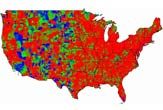Virtual Pandemic: 90 Days to Infect Entire U.S.

A new computer model reveals how a pandemic like the avian flu might spread quickly across the United States and what methods would best thwart the scenario.
Researchers assumed a starting point of 10 highly infectious influenza cases in Los Angeles, then let the model take it from there. The virus spread quickly, peaking in just 90 days with 100 or more infections per 1,000 residents of just about every corner of the country [Animated Map].
The simulation is an attempt to map out what might happen with a very uncertain bug: the avian flu virus H5N1 is a particular strain that does not yet easily pass between humans. If it morphs into such a strain, however, human deaths could mount quickly. Meantime, vaccines developed for current strains would likely not be effective against whatever variety ultimately emerges.
U.S. Health and Human Services Secretary Mike Leavitt has said the country is not prepared for such a scenario.
Lessons learned
The virtual pandemic suggests advance preparation of a modestly effective vaccine in large quantities is preferable to waiting to see exactly what strain emerges.
Quarantines, school closures and travel restrictions alone won't thwart the spread, but such measures can buy time while vaccines production is ramped up and tailored to the specific flu strain. In the simulation, long-range travel was cut to 10 percent of normal based on travel advisories that would presumably be instituted.
Sign up for the Live Science daily newsletter now
Get the world’s most fascinating discoveries delivered straight to your inbox.
"Based on our results, combinations of mitigation strategies such as stockpiling vaccines or antiviral agents, along with social distancing measures could be particularly effective in slowing pandemic flu spread in the U.S.," said Ira Longini, a biostatistician with the Fred Hutchinson Cancer Research Center and the University of Washington.
The variables
The model uses census data and 281 million synthetic people at work, play, school and home, along with Department of Transportation travel data that incorporates rapid spread from one city to another by air travel.
The computer model employs probabilities that an infected person will cross paths with others at home or, with lower probability, elsewhere.
"So we are only computing the probability of any person becoming infected on any given day, and a roll of the dice is needed to decide whether they are infected or not," said Timothy Germann of the Los Alamos National Laboratory.
The computer also considered one vexing aspect to the flu: About 33 percent of those infected don't develop symptoms and can unknowingly transmit the disease.
The Avian Flu Spread
- Human Death Toll from Bird Flu Tops 100
- Bird Flu Jumps to Cat in Germany
- New Bird Flu Concerns Italy, France, Egypt, India
- Tests Find Bird Flu in Egypt, France
- Bird Flu Reaches Western Europe
- Avian Flu Reaches Africa
U.S. Worries
- Bird Migration Has U.S. Experts Watching For Flu
- U.S. Not Prepared for Flu Pandemic
- Deadly Flu Will Reach U.S., Says Bird Migration Expert
- Bird Flu Pandemic Imminent, Health Official Says
- Avian Flu Could Reach U.S. Next Year
Flu Science
- SPECIAL REPORT: FLU FEARS
- How Bird Flu Infects Humans and Why We Don't Spread It
- Possible Path to Humans for Avian Flu Found
- Insides of Flu Virus Revealed
- Amid Avian Flu Fears, Other Bugs Far More Deadly
- Trojan Ducks: One More Possible Flu Carrier
- Scientists Recreate 1918 Flu Virus From Scratch
SPECIAL REPORT: FLU FEARS
What it is and how it affects us.
How to prevent and treat the flu.
How flu could become a global killer.

Animated Map: Starting with 10 cases in Los Angeles, how the flu might spread. Cases per one thousand people shown blue equals 1 or fewer red equals 100 or more. Credit: T. Germann et al., LANL
Robert is an independent health and science journalist and writer based in Phoenix, Arizona. He is a former editor-in-chief of Live Science with over 20 years of experience as a reporter and editor. He has worked on websites such as Space.com and Tom's Guide, and is a contributor on Medium, covering how we age and how to optimize the mind and body through time. He has a journalism degree from Humboldt State University in California.
